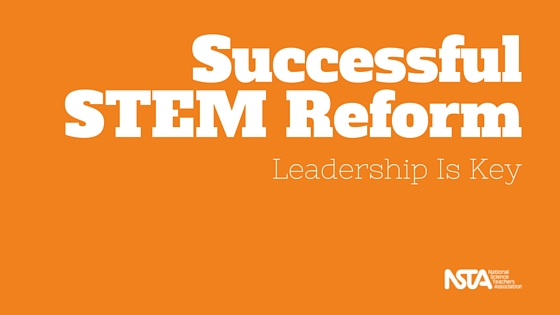Successful STEM Reform: Leadership Is Key
By Guest Blogger
Posted on 2015-09-30
A recent Education Week blog post entitled “STEM Reforms in Needy Schools Eroded Quickly” painted a disappointing picture of STEM education reform. In this post, part 1 of a 2-part series* from the National Science Teachers Association (NSTA), Dr. Cary Sneider (Associate Research Professor at Portland State University in Portland, Oregon) responds.
Schools have a great deal of momentum. They are very difficult to change—especially if just one part of the system is changed without taking into account interactions with other parts of the system. Approving systemic changes to accommodate STEM reform takes political will and therefore support from top educational leaders. Although I don’t know the details of these particular schools, support from top leaders may be a common thread for the problems identified in the report. For example:
Schedule conflicts: The report mentioned scheduling nightmares when guidance counselors tried to fit new STEM courses into existing core requirements. It seems obvious that it would not be possible to incorporate new STEM courses without appropriate modifications to core requirements. The root cause of such a conflict must lie with the people who make policy decisions. If they support STEM reform then they will change the rules to allow it; if they don’t they will block the necessary changes.
State accountability tests: We set an impossible goal when we ask teachers to implement new teaching methods with new goals, and hold them accountable for their students to perform at a high level on the old assessments. New performance-based assessments, consistent with new STEM standards have not yet been developed in any state, and until they are educational leaders should not use inappropriate measures to judge teachers and students.
Personnel changes: The report mentions that courses like physiology and robotics were advertised to students and never actually offered. There could be many reasons why such problems occur (or in this case didn’t occur,) but whatever the reason, teachers were not in a position to offer those courses. Since the deployment of staff to teach various courses is a function of administration, it is likely that these courses did not have sufficient support from the top.
Successful STEM reform addresses these issues from the start. Sneider will be discussing the systemic approach required for educational change on November 7 in the NSTA Virtual Conference Shifting to Integrated STEM: Experiences of Three School Districts. Sneider explains that changing educational systems requires a willingness to examine—and if necessary change—existing policies. He and his co-presenters will give several examples in which systemic changes have brought about significant improvements in STEM teaching and learning. They will also discuss what it takes to implement such changes, including the absolute requirement of support by top leaders. Learn more and register. Register early by Friday, October 9, and save $10 off your registration fee: Use promo code NOV_SAVE10.
 Dr. Cary Sneider is Associate Research Professor at Portland State University in Portland, Oregon, where he teaches courses in research methodology in a Master of Science Teaching degree program.
Dr. Cary Sneider is Associate Research Professor at Portland State University in Portland, Oregon, where he teaches courses in research methodology in a Master of Science Teaching degree program.
Read Part 2 of this series: 3 Key Ingredients for Successful STEM Implementation: Trust, Collaboration, and Innovative Thinking
The mission of NSTA is to promote excellence and innovation in science teaching and learning for all.
Follow NSTA
Disclaimer: The views expressed in this blog post are those of the author(s) and do not necessarily reflect the official position of the National Science Teaching Association (NSTA).



